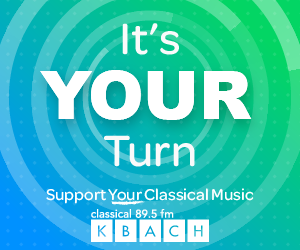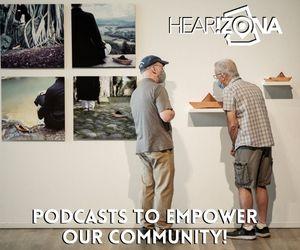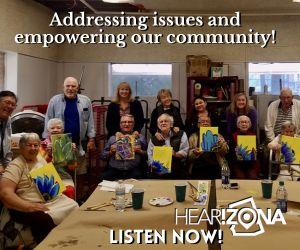Click to Listen:
Legendary Violinist Dmitry Sitkovetsky joins violist Scott Rawls and cellist Zuill Bailey for a performance of his groundbreaking transcription of Bach's Goldberg Variations, 7:30pm, Thursday, October 22, 2015, at the Mesa Arts Center. K-BACH's Sterling Beeaff catches up with Dmitry about the work, and his original inspiration.
SB: Well, it is a privilege to be able to sit with you, Dmitry Sitkovetsky. Long time no see.
DS: Yes, as we figured out, more than 20 years, my goodness.
SB. Welcome back to the Valley.
DS: It’s wonderful to be back.
SB: You know, your own musical journey is almost legend, your parents, and then your journey to this country. There are the transcriptions that you will be playing at Mesa Arts Center tomorrow night. This is its own musical journey, for actually, for everyone.
DS: That’s true.
SB. It surprised me though, because it is a 1981 recording that you are really fascinated by – of the Goldberg Variations.
DS: I think if it weren’t for my own rediscovery of Glenn Gould, it is not as if I was not aware of his presence…he came to Russia when I was probably just three years old and I heard his early recording, you know, while growing up. But somehow that late recording affected me in a way no other recording did before, and also the video I saw- he made a video with Bruno Monsaingeon. That was quite something, so I became a little obsessed with the piece of music, with him, with him as sort of a musical equivalent of “E.T”, you know that came from another galaxy, and sort of illuminated everything, and was just so strange, and unlike the rest of us, then left and affected a lot of people. But basically, with all the followers that he had, there is no Glenn Gould clones. You can not really be like him –not like one would want to be like him, as a person or a human being. Anyway, but he was unique, and he certainly illuminated the piece in a way that I realized that most of the Goldberg variations are written for three part counterpoint; every third variation is a canon, which they go further and further away from each other. And so that gave me an idea, maybe, this will work for string trio.
SB: When was that?
DY: It was 83. It was exactly in 83, and I remember very well the beginning of December, aaah, I, having listened already all the time to his recording, and I bought the original and I‘d listen. I’d follow, not just listen, and I realized, maybe, just as an exercise, for my own amusement, maybe I’d write it out. And sure enough, it was an incredibly joyful and fascinating journey, being in the company of Bach and Glen Gould that is pretty exalted company. I finished it in 2 months, really, all in long hand of course, all in pencil, so I could make adjustments. I even took out, for a couple of weeks, a viola, which I never played before or since, (laughter) so just to see violas could negotiate those difficult passages, especially when they imitate the violin and those canons and all that. But it all worked out, but everyone thought I was out of my mind.
SB: I wanted to talk about that, because that would be hard for, especially younger people, to even comprehend. I remember critics, even musicians saying, you don’t do that. Bach was the ultimate guy-
DY: Exactly! If anyone would have done it, it would have been him! He thought nothing of taking Vivaldi’s concerto for 4 violins and making it his own concerto for 4 harpsichords, and nobody sued him for copyright infringement or whatever. He took what every worked. He didn’t always have the position in Leipzig. He played the instruments he had available. There is a reason why he wrote the sonatas and partitas in Cöthen because he didn’t have the organ position that he was looking for. He went to Hamburg and auditioned in the big church and lost, even though he was clearly the best organist around. But politics were ripe even back then- it is all human nature.
SB: So the detractors that you had, the folks that said, “You are crazy, Dmitry, don’t do this.” Were they your own teachers?
DY: Not only, but teachers, I never took it to any teachers. First of all, the very people who recorded and played it with me originally, Mischa Maisky and Gérard Caussé, friends, old friends and wonderful colleagues, they couldn’t believe what I was asking them to do. I said, “Let’s just sit down and read.” We were rehearsing for something else, and it was in my house, they had no place to go. So I sort of set them down, and an hour and a half later, they just got up after really being forced. Little did they know they were going to play this piece hundreds of times, and still play, and record it, not just with me, but with many other musicians. At that time my own managers laughed at me, “Oh come on now, transcriptions…no, no…” That’s just like a dirty word in those days. The purity of style, the whole thing, well now, look who is laughing, and look who is getting commissions for transcriptions! As we speak, I just completed a major transcription for the Orpheus Chamber Orchestra. It is Stravinsky’s Divertimento, of course, Fairy’s Kiss, is an orchestral piece, also violin and piano, but I made it into a violin and orchestra. Another violin concerto coming up.
SB: Interesting.
DY: So these days I get commissions. I also transcribed 12 Chopin Preludes for Verbier Festival a couple of years ago, 20th anniversary, for everybody who played there. That was very popular.
SB: When did those first players –at what point did they say you were right?
DY: Well, I guess when we played it for the first time, at my festival in Finland, also in Newport, Rhode Island. When they saw the reaction of the people, and then when we made a recording soon after that, and then we only had two kinds of reviews for that: Incredibly FOR, or incredibly AGAINST it.
SB: Isn’t that how you know you’ve done something right, though?
Laughter
DY: Then I knew I had done something right. Absolutely.
SB: Have you revisited the transcriptions?
DS: Several times. And it might not be the last time yet. I revisited when I started to conduct, and that was already in 1990. I still had that fabulous Finnish festival which was like my musical laboratory; this is where all my first experiments were tried, that wonderful audience. My friends, half of them were from Russia, half were all Russian trained, half were Western—they all knew and played already some of them, these string trios. They said, “Aw, come on- do the transcriptions.” They said, “Please do”, and I resisted for a couple of years, and then I finally did, and that became a bestseller on Nonesuch. I have done it with many, many orchestras all over the world, major symphony orchestras, not only chamber orchestras. So that was the second incarnation of the piece if you like, in my hands. And then the third one is a little bit influenced by the second one, because I had a bigger field to play with. I had a double bass, a harpsichord continuo, it is very sort of a visual kind of thing. The interesting thing about it of course it is a string trio as well, and this is one rare situation, unlike the original which is just two hands, for manual harpsichord or piano, because you can actually watch polyphony. There are the three voices, and you can see how they interact. How I start a canon and then viola plays exactly the same, then it is unison, and cello is playing variations on the theme, supporting us. Then they get further and further, that is already a visual. Now when you see the orchestral one that is even more so, you have groups, tutti and soli and all that. Finally, so many people recorded it, including my friends. They should remember how they first responded to it. (Laughter) But anyway, so when I did a recent one, that’s the one I will play tomorrow here in Mesa, some variations have been changed a little bit, some morepizzicato added, octaves, original octaves restored, (So many wonderful violists, I don’t have to bring it down an octave for certain things to make sure the viola can play it), and so forth. This is more for my second recording of this piece, or third already, in 2010 for Nimbus, and I did it with members of my chamber orchestra, Luigi Piovano is a fantastic cellist from Italy, and Yuri Zhislin is also somebody I brought up in my NES Chamber Orchestra, so that was together with the 15 symphonies, which we also do tomorrow.
SB: In my head this came to together because Zuill Bailey is so involved with Mesa (Arts Center) as guest director.
DS:Exactly.
SB: Did he approach you?
DS: Yeah. Zuill, first of all, we met in Greensborough, which is my orchestra which has been mine for 10 years as music director, and we, from time to time, do a sort of a combined Greensborough/Winston Salem Orchestra, and he has been coming to Winston Salem for quite some time, he is friends with Bob Moody, who is also my friend. So we did this big program where he did Don Quixote, and I conducted him for two performances, and I liked him very much. He is very gregarious.
SB: Now the third member, the violist, is from Greensborough?
DS. Scott Rawls, he’s from Greensborough. He played in New York, but he’s originally from North Carolina. He’s a wonderful player. He was Sancho Panza in Don Quixote, and that ‘s why Zuill said “let’s play with him”. We first went in January to El Paso to his festival there, and we played all kinds of things, including this, and then this performance came about. Very much because of Zuill.
SB. Ok, well, there is something extraordinary very often, following someone’s journey, and you following your bliss, and bringing Bach in your back pocket and letting us share the journey with you, tomorrow at the Mesa Arts Center. Dimitry Sitkovetsky, it is great to see you.
DS: Wonderful to be back. Thanks so much.
Produced by Jane Hilton










